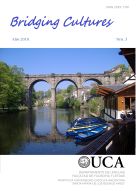Please use this identifier to cite or link to this item:
https://repositorio.uca.edu.ar/handle/123456789/4994| Título: | The future of artificial intelligence : mankind quest for replicating human intelligence | Autor: | Welle, Rosario F. | Palabras clave: | INTELIGENCIA ARTIFICIAL; TECNOLOGIA DIGITAL; CIENCIA; COMUNICACION | Fecha de publicación: | 2018 | Editorial: | Universidad Católica Argentina. Facultad de Filosofía y Letras. Departamento de Lenguas | Cita: | Welle, Rosario F. “The future of artificial intelligence : mankind quest for replicating human intelligence” [en línea]. Bridging Cultures, 3 (2018). Disponible en: https://repositorio.uca.edu.ar/handle/123456789/4994 | Resumen: | Artificial intelligence (AI) is defined as “the scientific study and engineering of intelligent machines” (Luxton, 2013). This technology allows devices and tools to behave in a human-like intelligent manner to “emulate reasoning and language processing” (2013). According to a Report to ARPA on Twenty-First Century Intelligent (n.d.), AI has emerged to answer researchers’ argument that computer systems are “rigid, complex, and incapable of rapid change”. By becoming “intelligent”, these systems can adapt to the fast-evolving technology and meet technological needs of major national areas in communication, military, healthcare, and education. As a result, in the past two decades, we have witnessed major advancements in the emerging and development of smart devices such as the smartphone. In fact, the Report to ARPA indicates that researchers already predicted a future in which people would have a single device integrated with telephone, Internet, television capabilities, news, and, electronic mail... | URI: | https://repositorio.uca.edu.ar/handle/123456789/4994 | Disciplina: | LENGUA | Derechos: | Acceso Abierto | Fuente: | Bridging Cultures Nº 3, 2018 |
| Appears in Collections: | BC - 2018 nro. 03 |
Files in This Item:
| File | Description | Size | Format | |
|---|---|---|---|---|
| future-artificial-intelligence-welle.pdf | 368,5 kB | Adobe PDF |  View/Open |
Page view(s)
294
checked on Apr 27, 2024
Download(s)
153
checked on Apr 27, 2024
Google ScholarTM
Check
This item is licensed under a Creative Commons License

